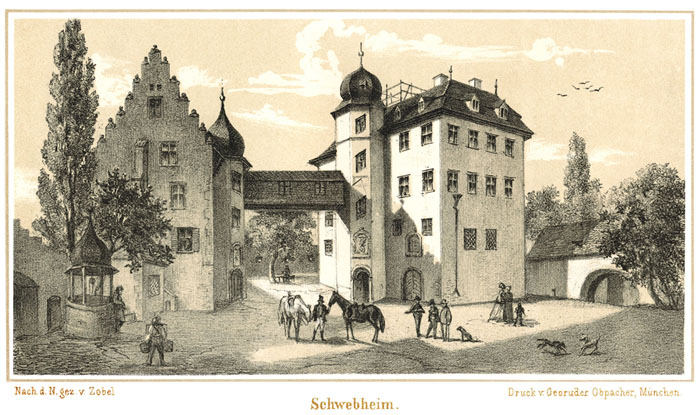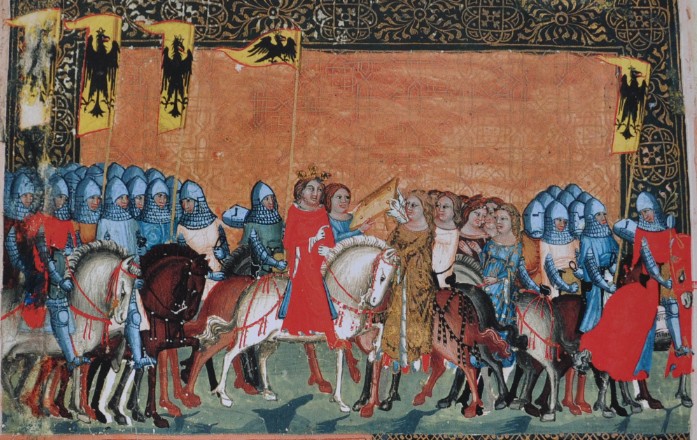|
Schwebheim
Schwebheim is a municipality in the district of Schweinfurt in Bavaria, Germany. Historically important as the location of the Bibra family castle by the same name. The castle was heavily damaged during severe bombings of Schweinfurt in World War II and only partially repaired. Today, the village is fast becoming a suburb of nearby Schweinfurt. Sons & Daughters of the Town *Ernst von Bibra Ernst von Bibra (9 June 1806 in Schwebheim – 5 June 1878 in Nuremberg) was a German Naturalist ( Natural history scientist) and author. Ernst was a botanist, zoologist, metallurgist, chemist, geographer, travel writer, novelist, duelli ... (1806–1878), botanist, zoologist, metallurgist, chemist, geographer, travel writer, novelist, duellist, art collector and trailblazer in ethnopsychopharmacology *Abraham Adler (1850–1922), Economist References External links * Schweinfurt (district) Bibra family {{Schweinfurtdistrict-geo-stub ... [...More Info...] [...Related Items...] OR: [Wikipedia] [Google] [Baidu] |
Ernst Von Bibra
Ernst von Bibra (9 June 1806 in Schwebheim – 5 June 1878 in Nuremberg) was a German Naturalist ( Natural history scientist) and author. Ernst was a botanist, zoologist, metallurgist, chemist, geographer, travel writer, novelist, duellist, art collector and trailblazer in ethnopsychopharmacology. Biography Ernst's father, Ferdinand Johann von Bibra, (*1756; † 1807), fought under General Rochambeau in the American Revolutionary War on behalf of the colonies. Later he married his brother's daughter, Lucretia Wilhelmine Caroline von Bibra,(b.1778 - d. + 1857). Ernst's father died when he was 1½ years old, and Baron Christoph Franz von Hutten (d. 1830) raised Ernst in Würzburg. He graduated at nineteen from a boarding school in Neuberg on the Danube. Baron Ernst von Bibra started studying law at Würzburg but soon changed over to the natural sciences, especially chemistry. ("Dr. med. & phil." Doctor of medicine & PhD) Martin Haseneier, in his foreword to the 1995 trans ... [...More Info...] [...Related Items...] OR: [Wikipedia] [Google] [Baidu] |
Von Bibra
The House of Bibra () was one of the leading ''Uradel'' (ancient noble) families in Franconia (northern part of Bavaria) and present day Thuringia from the mid-15th century to about 1600. Later on the family rose from ''Reichsritter'' (Imperial Knights) to ''Reichsfreiherr'' (Barons of the Holy Roman Empire). After the Holy Roman Empire dissolved, they were made ‘’Freiherr’‘ (Barons) of Bavaria and Bohemia. History The earliest references to the family include a document of Bishop Otto of Bamberg from the year 1119 of a ''Rupertus de Bibra''. In 1151 a ''Pertholdus (Berthold) de Bibra'' and his sons ''Pertholdus (Berthold)'' and ''Tagino'' are referenced in another document. The family prospered in numbers, wealth, and influence in the 15th century and early 16th century. By the time of Siebmachers Wappenbuch of 1605, the family is listed as the most important family of Franconia under the rank of Freiherr. By 1600 most of the family died off without hei ... [...More Info...] [...Related Items...] OR: [Wikipedia] [Google] [Baidu] |
Schweinfurt
Schweinfurt ( , ; ) is a city in the district of Lower Franconia in Bavaria, Germany. It is the administrative centre of the surrounding district (''Landkreis'') of Schweinfurt and a major industrial, cultural and educational hub. The urban agglomeration has 100,200 (2018) and the city's catchment area, including the Main-Rhön region and parts of South Thuringia, 759,000 inhabitants. Schweinfurt was first documented in 791 and is one of the oldest cities in Bavaria. Around 1000 the Margraves of Schweinfurt controlled large parts of northern Bavaria. From the 12th century until 1802 Schweinfurt was a Free imperial city within the Holy Roman Empire, around 1700 a humanistic centre and in 1770 began the 250-year industrial history. During World War II, the Americans suffered their biggest air defeat over Schweinfurt in the Second Raid on Schweinfurt ''(Black Thursday)''. On 11 April 1945, the US Army invaded the city. During the Cold ... [...More Info...] [...Related Items...] OR: [Wikipedia] [Google] [Baidu] |
Schweinfurt (district)
Schweinfurt is a ''Landkreis'' (district) in the northwestern part of Bavaria, Germany. Neighboring districts are (from the north clockwise) Bad Kissingen, Rhön-Grabfeld, Haßberge, Bamberg, Kitzingen, Würzburg and Main-Spessart. The district-free city Schweinfurt is surrounded by the district. Geography Primary rivers in the district are the Main and the Wern. The district is located between several hill chains - Haßberge to the east, the Rhön in the northwest, the Spessart to the west and the Steigerwald in the southeast. History The area of the district became part of Bavaria in 1814. In 1972 parts of the previous district Gerolzhofen (including the town Gerolzhofen) were merged with the district. Archaeology In July 2022, archaeologists announced the discovery of a 3000-year-old clay figurine that might represent a prehistoric female water goddess. The 19 cm tall clay figurine's carefully modeled eye sockets, nose, lips, and chin are obviously visible and attractiv ... [...More Info...] [...Related Items...] OR: [Wikipedia] [Google] [Baidu] |
Bayerisches Landesamt Für Statistik
The statistical offices of the German states (German language, German: ''Statistische Landesämter'') carry out the task of collecting official statistics in Germany together and in cooperation with the Federal Statistical Office of Germany, Federal Statistical Office. The implementation of statistics according to Article 83 of the Basic Law for the Federal Republic of Germany, constitution is executed at state level. The Bundestag, federal government has, under Article 73 (1) 11. of the constitution, the exclusive legislation for the "statistics for federal purposes." There are 14 statistical offices for the States of Germany, 16 states: See also * Federal Statistical Office of Germany References {{Reflist National statistical services, Germany Lists of organisations based in Germany, Statistical offices Official statistics, Germany ... [...More Info...] [...Related Items...] OR: [Wikipedia] [Google] [Baidu] |
Municipalities Of Germany
MunicipalitiesCountry Compendium. A companion to the English Style Guide European Commission, May 2021, pages 58–59. (german: Gemeinden, ) are the lowest level of official territorial division in . This can be the second, third, fourth or fifth level of territorial division, depending on the status of the municipality and the '''' (federal state) it ... [...More Info...] [...Related Items...] OR: [Wikipedia] [Google] [Baidu] |
Bavaria
Bavaria ( ; ), officially the Free State of Bavaria (german: Freistaat Bayern, link=no ), is a state in the south-east of Germany. With an area of , Bavaria is the largest German state by land area, comprising roughly a fifth of the total land area of Germany. With over 13 million inhabitants, it is second in population only to North Rhine-Westphalia, but due to its large size its population density is below the German average. Bavaria's main cities are Munich (its capital and largest city and also the third largest city in Germany), Nuremberg, and Augsburg. The history of Bavaria includes its earliest settlement by Iron Age Celtic tribes, followed by the conquests of the Roman Empire in the 1st century BC, when the territory was incorporated into the provinces of Raetia and Noricum. It became the Duchy of Bavaria (a stem duchy) in the 6th century AD following the collapse of the Western Roman Empire. It was later incorporated into the Holy Roman Empire, became an ind ... [...More Info...] [...Related Items...] OR: [Wikipedia] [Google] [Baidu] |
Germany
Germany,, officially the Federal Republic of Germany, is a country in Central Europe. It is the second most populous country in Europe after Russia, and the most populous member state of the European Union. Germany is situated between the Baltic and North seas to the north, and the Alps to the south; it covers an area of , with a population of almost 84 million within its 16 constituent states. Germany borders Denmark to the north, Poland and the Czech Republic to the east, Austria and Switzerland to the south, and France, Luxembourg, Belgium, and the Netherlands to the west. The nation's capital and most populous city is Berlin and its financial centre is Frankfurt; the largest urban area is the Ruhr. Various Germanic tribes have inhabited the northern parts of modern Germany since classical antiquity. A region named Germania was documented before AD 100. In 962, the Kingdom of Germany formed the bulk of the Holy Roman Empire. During the 16th ce ... [...More Info...] [...Related Items...] OR: [Wikipedia] [Google] [Baidu] |


